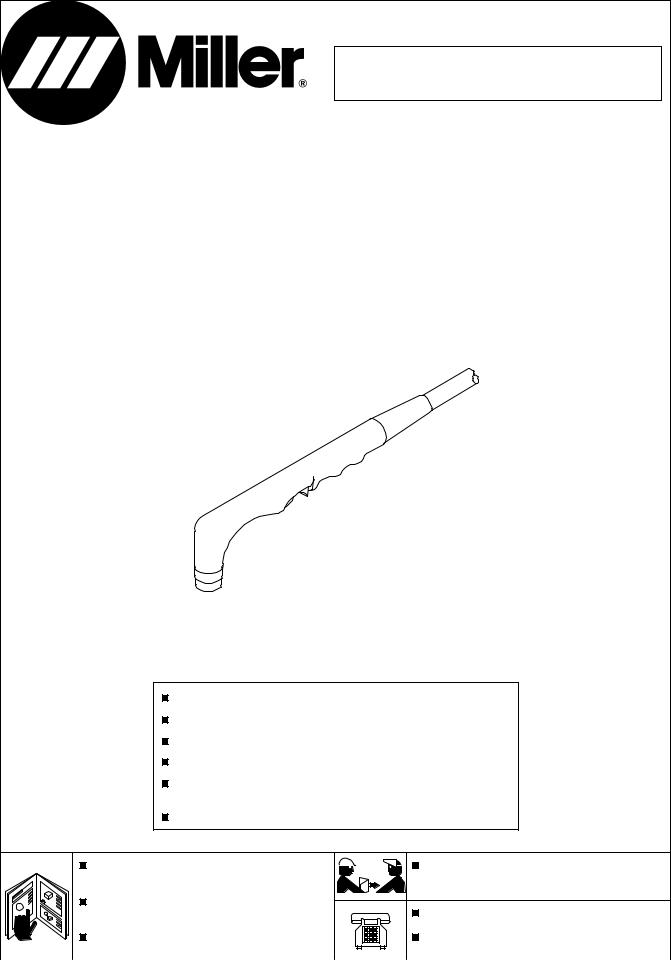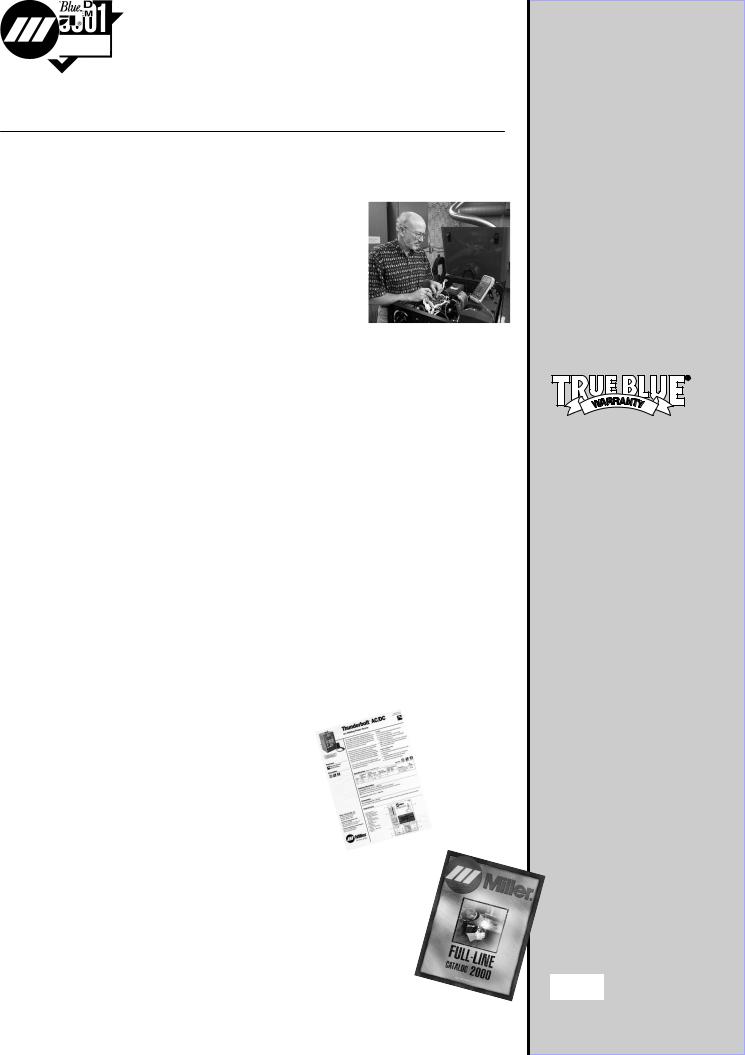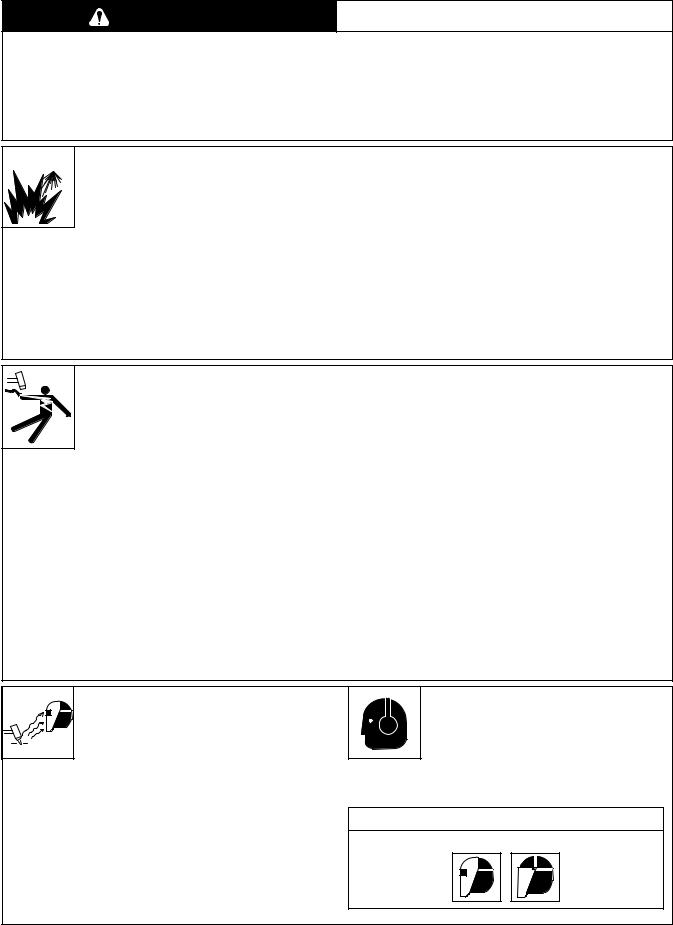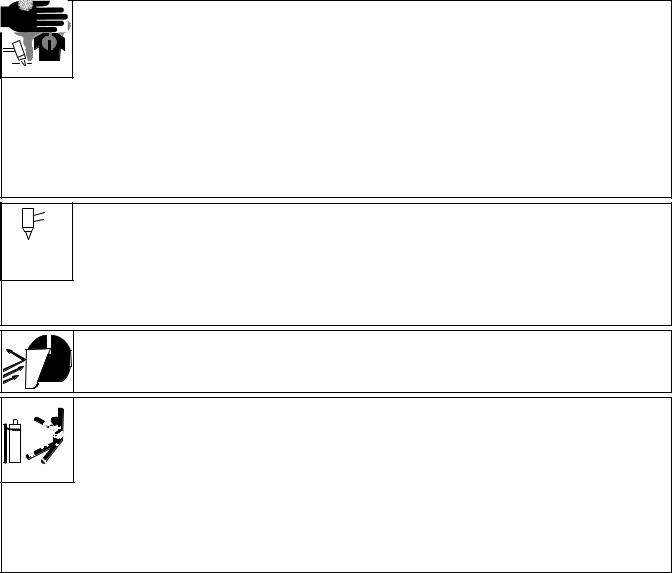Miller Electric MC-80, MC-80M User Manual

May 1995 Form: OM-1592A
OWNER’S
MANUAL
MC-80 And MC-80M
Air-Cooled Plasma Arc Cutting (PAC) Torches
Can Be Used For Plasma Arc Gouging (PAG)
80 Amperes, 120 Volts DC At 100% Duty Cycle
Safety Interlock Devices Shut Down Power Source
Hand-Held Torch Equipped With Either 25 Or 50 ft (7.6 Or 15.2 m) Cable
Machine-Held Torch Equipped With 50 ft (15.2 m) Cable
Fully Assembled And Supplied With Consumable Kit
Read and follow these instructions and all safety blocks carefully.
Have only trained and qualified persons install, operate, or service this unit.
Call your distributor if you do not understand the directions.
Give this manual to the operator.
For help, call your distributor
or: MILLER Electric Mfg. Co., P.O. Box 1079, Appleton, WI 54912 414-734-9821
cover 5/94 – Ref. ST-800 895 |
1995 MILLER Electric Mfg. Co. |
PRINTED IN USA |

From Miller to You
Thank you and congratulations on choosing Miller. Now you can get the job done and get it done right. We know you don’t have time to do it any other way.
That’s why when Niels Miller first started building arc welders in 1929, he made sure his products offered long-lasting value and superior quality. Like you, his customers couldn’t afford anything less. Miller products had to be more than the best they could be. They had to be the best you could buy.
Today, the people that build and sell Miller products continue the tradition. They’re just as committed to providing equipment and service that meets the high standards of quality and value established in 1929.
This Owner’s Manual is designed to help you get the most out of your Miller products. Please take time to read the Safety precautions. They will help you protect yourself against potential hazards on the worksite. We’ve
made installation and operation quick and easy. With Miller you can count on years of reliable service with proper maintenance. And if for some reason the unit needs repair, there’s a Troubleshooting section that will help you figure out what the problem is. The parts list will then help you to decide which exact part you may need to fix the problem. Warranty and service information for your particular model are also provided.
Miller Electric manufactures a full line
of welders and welding related equipment. For information on other quality Miller products, contact your local Miller distributor to receive the latest full line catalog or
individual catalog sheets. To locate your nearest distributor or service agency call 1-800-4-A-Miller, or visit us at www.MillerWelds.com on the web.
Working as hard as you do
– every power source from Miller is backed by the most hassle-free warranty in the business.
Miller offers a Technical Manual which provides more detailed service and parts information for your unit. To obtain a Technical Manual, contact your local distributor. Your distributor can also supply you with Welding Process Manuals such as SMAW, GTAW,
GMAW, and GMAW-P.

PLASMA ARC CUTTING SAFETY PRECAUTIONS
WARNING
PLASMA ARC CUTTING can be hazardous.
PROTECT YOURSELF AND OTHERS FROM POSSIBLE SERIOUS INJURY OR DEATH. KEEP CHILDREN AWAY. PACEMAKER WEARERS KEEP AWAY UNTIL CONSULTING YOUR DOCTOR.
In cutting, as in most jobs, exposure to certain hazards occurs. Cutting is safe when precautions are taken. The safety information given below is only a summary of the more complete safety information that will be found in the Safety Standards listed on the next page. Read and follow all Safety Standards.
HAVE ALL INSTALLATION, OPERATION, MAINTENANCE, AND REPAIR WORK PERFORMED ONLY BY QUALIFIED PEOPLE.
 CUTTING can cause fire or explosion.
CUTTING can cause fire or explosion.
Hot metal and sparks blow out from the cutting arc.
The flying sparks and hot metal, hot workpiece, and hot equipment can cause fires and burns. Check and be sure the area is safe before doing any cutting.
7.Do not cut on closed containers such as tanks or drums.
8.Connect work cable to the work as close to the cutting area as practical to prevent cutting current from traveling long, possibly unknown paths and causing electric shock and fire hazards.
9.Never cut containers with potentially flammable materials inside
– they must be emptied and properly cleaned first.
1.Protect yourself and others from flying sparks and hot metal.
2.Do not cut where flying sparks can strike flammable material.
3.Remove all flammables within 35 ft (10.7 m) of the cutting arc. If this is not possible, tightly cover them with approved covers.
4.Be alert that sparks and hot materials from cutting can easily go through small cracks and openings to adjacent areas.
10.Do not cut in atmospheres containing explosive dust or vapors.
11.Do not cut pressurized cylinders, pipes, or vessels.
12.Do not cut containers that have held combustibles.
13.Wear oil-free protective garments such as leather gloves, heavy shirt, cuffless trousers, high shoes, and a cap.
5.Watch for fire, and keep a fire extinguisher nearby.
6.Be aware that cutting on a ceiling, floor, bulkhead, or partition can cause fire on the hidden side.
14.Do not locate unit on or over combustible surfaces.
15.Remove any combustibles, such as a butane lighter or matches, from your person before doing any cutting.
ELECTRIC SHOCK can kill.
Touching live electrical parts can cause fatal shocks or severe burns. The torch and work circuit is electrically live whenever the output is on. The input power circuit and machine internal circuits are also live when power is on. Plasma arc cutting requires higher voltages than welding to start and maintain the
arc (200 to 400 volts dc are common), but also uses torches designed with safety interlock systems which turn off the machine when the shield cup is loosened or if tip touches electrode inside the nozzle.
Incorrectly installed or improperly grounded equipment is a hazard.
1.Do not touch live electrical parts.
2.Wear dry, hole-free insulating gloves and body protection.
3.Insulate yourself from work and ground using dry insulating mats or covers big enough to prevent any physical contact with the work or ground.
4.Do not touch torch parts if in contact with the work or ground.
5.Turn off power before checking, cleaning, or changing torch parts.
6.Disconnect input power before installing or servicing this equipment. Lockout/tagout input power according to OSHA CFR 1910.147 (see Safety Standards).
7.Properly install and ground this equipment according to its Owner’s Manual and national, state, and local codes.
8.Check and be sure that input power cord ground wire is properly connected to ground terminal in disconnect box or that cord plug is connected to a properly grounded receptacle outlet – always verify the supply ground.
9.When making input connections, attach proper grounding conductor first.
10.Frequently inspect input power cord for damage or bare wiring – replace cord immediately if damaged – bare wiring can kill.
11.Turn off all equipment when not in use.
12.Inspect and replace any worn or damaged torch cable leads.
13.Do not wrap torch cable around your body.
14.Ground the workpiece to a good electrical (earth) ground if required by codes.
15.Use only well-maintained equipment. Repair or replace damaged parts at once.
16.Wear a safety harness if working above floor level.
17.Keep all panels and covers securely in place.
18.Do not bypass or try to defeat the safety interlock systems.
19.Use only torch(es) specified in Owner’s Manual.
20.Keep away from torch tip and pilot arc when trigger is pressed.
21.Clamp work cable with good metal-to-metal contact to workpiece
(not piece that will fall away) or worktable as near the cut as practical.
ARC RAYS can burn eyes and skin.
Arc rays from the cutting process produce intense visible and invisible (ultraviolet and infrared) rays that can burn eyes and skin.
1.Wear face protection (helmet or shield) with correct shade of filter to protect your face and eyes when cutting or watching. ANSI Z49.1 (see Safety Standards) suggests a No. 9 shade (with No. 8 as minimum) for all cutting currents less than 300 amperes.
Z49.1 adds that lighter filter shades may be used when the arc is hidden by the workpiece. As this is normally the case with low current cutting, the shades suggested in Table 1 are provided for the operator’s convenience.
2.Wear approved safety glasses with side shields.
3.Use protective screens or barriers to protect others from flash and glare; warn others not to watch the arc.
4.Wear protective clothing made from durable, flame-resistant material (wool and leather) and foot protection.
NOISE can damage hearing.
Prolonged noise from some cutting applications can damage hearing if levels exceed limits specified by
OSHA (see Safety Standards).
1.Use approved ear plugs or ear muffs if noise level is high.
2.Warn others nearby about noise hazard.
Table 1. Eye Protection For Plasma Arc Cutting
Current Level In Amperes |
Minimum Shade Number |
Below 20 |
#4 |
20 – 40 |
#5 |
40 – 60 |
#6 |
60 – 80 |
#8 |
sr2 11/92

FUMES AND GASES can be hazardous to your health.
Cutting produces fumes and gases. Breathing these fumes and gases can be hazardous to your health.
1.Keep your head out of the fumes. Do not breathe the fumes.
2.If inside, ventilate the area and/or use exhaust at the arc to remove cutting fumes and gases.
3.If ventilation is poor, use an approved air-supplied respirator.
4.Read the Material Safety Data Sheets (MSDSs) and the manufacturer’s instruction for metals to be cut, coatings, and cleaners.
5.Work in a confined space only if it is well ventilated, or while wearing an air-supplied respirator. Fumes from cutting and oxygen depletion can alter air quality causing injury or death. Be sure the breathing air is safe.
6.Do not cut in locations near degreasing, cleaning, or spraying operations. The heat and rays of the arc can react with vapors to form highly toxic and irritating gases.
7.Do not cut on coated metals, such as galvanized, lead, or cadmium plated steel, unless the coating is removed from the cutting area, the area is well ventilated, and if necessary, while wearing an air-supplied respirator. The coatings and any metals containing these elements can give off toxic fumes when cut.
8.Do not cut containers with toxic or reactive materials inside or containers that have held toxic or reactive materials – they must be emptied and properly cleaned first.
PLASMA ARC can cause injury.
The heat from the plasma arc can cause serious burns. The force of the arc adds greatly to the burn hazard. The intensely hot and powerful arc can quickly cut through gloves and tissue.
1.Keep away from the torch tip.
2.Do not grip material near the cutting path.
3.The pilot arc can cause burns – keep away from torch tip when trigger is pressed.
4.Wear proper flame-retardant clothing covering all exposed body areas.
5.Point torch away from your body and toward work when pressing the torch trigger – pilot arc comes on immediately.
6.Turn off power source and disconnect input power before disassembling torch or changing torch parts.
7.Use only torch(es) specified in the Owner’s Manual.
FLYING SPARKS AND HOT METAL can  cause injury.
cause injury.
Chipping and grinding cause flying metal. As welds cool, they can throw off slag.
1.Wear approved face shield or safety goggles with side shields.
2.Wear proper body protection to protect skin.
3.Wear flame-resistant ear plugs or ear muffs to prevent sparks from entering ears.
CYLINDERS can explode if damaged.
Gas cylinders contain gas under high pressure. If damaged, a cylinder can explode. Since gas cylinders are normally part of metalworking processes, be sure to treat them carefully.
1.Protect compressed gas cylinders from excessive heat, mechanical shocks, slag, open flame, sparks, and arcs.
2.Install and secure cylinders in an upright position by chaining them to a stationary support or equipment cylinder rack to prevent falling or tipping.
3.Keep cylinders away from any cutting or other electrical circuits.
4.Never allow electrical contact between a plasma arc torch and a cylinder.
5.Never cut on a pressurized cylinder – explosion will result.
6.Use only correct gas cylinders, regulators, hoses, and fittings designed for the specific application; maintain them and associated parts in good condition.
7.Turn face away from valve outlet when opening cylinder valve.
8.Keep protective cap in place over valve except when cylinder is in use or connected for use.
9.Read and follow instructions on compressed gas cylinders, associated equipment, and CGA publication P-1 listed in Safety
Standards.
PRINCIPAL SAFETY STANDARDS
Safety in Welding and Cutting, ANSI Standard Z49.1, from American Welding Society, 550 N.W. LeJeune Rd, Miami FL 33126
Safety and Health Standards, OSHA 29 CFR 1910, from Superintendent of Documents, U.S. Government Printing Office, Washington, D.C. 20402.
Recommended Practices for Plasma Arc Cutting, American Welding
Society Standard AWS C5.2, from American Welding Society, 550 N.W.
LeJeune Rd, Miami, FL 33126
Recommended Safe Practices for the Preparation for Welding and Cutting of Containers That Have Held Hazardous Substances, American
Welding Society Standard AWS F4.1, from American Welding Society, 550 N.W. LeJeune Rd, Miami, FL 33126
National Electrical Code, NFPA Standard 70, from National Fire Protection Association, Batterymarch Park, Quincy, MA 02269.
Safe Handling of Compressed Gases in Cylinders, CGA Pamphlet P-1, from Compressed Gas Association, 1235 Jefferson Davis Highway,
Suite 501, Arlington, VA 22202.
Code for Safety in Welding and Cutting, CSA Standard W117.2, from
Canadian Standards Association, Standards Sales, 178 Rexdale Boulevard, Rexdale, Ontario, Canada M9W 1R3.
Safe Practices For Occupation And Educational Eye And Face Protection, ANSI Standard Z87.1, from American National Standards Institute, 1430 Broadway, New York, NY 10018.
Cutting And Welding Processes, NFPA Standard 51B, from National Fire Protection Association, Batterymarch Park, Quincy, MA 02269.
sr2 11/92

EMF INFORMATION
NOTE
Considerations About Welding And The Effects Of Low Frequency Electric And Magnetic Fields
The following is a quotation from the General Conclusions Section of the U.S. Congress, Office of Technology Assessment, Biological Effects of Power Frequency Electric & Magnetic Fields – Background Paper, OTA-BP-E-53 (Washington, DC: U.S. Government Printing Office, May 1989): “. . . there is now a very large volume of scientific findings based on experiments at the cellular level and from studies with animals and people which clearly establish that low frequency magnetic fields can interact with, and produce changes in, biological systems. While most of this work is of very high quality, the results are complex. Current scientific understanding does not yet allow us to interpret the evidence in a single coherent framework. Even more frustrating, it does not yet allow us to draw definite conclusions about questions of possible risk or to offer clear science-based advice on strategies to minimize or avoid potential risks.”
To reduce magnetic fields in the workplace, use the following procedures:
1.Keep cables close together by twisting or taping them.
2.Arrange cables to one side and away from the operator.
3.Do not coil or drape cables around the body.
4.Keep welding power source and cables as far away as practical.
5.Connect work clamp to workpiece as close to the weld as possible.
About Pacemakers:
The above procedures are among those also normally recommended for pacemaker wearers. Consult your doctor for complete information.
TABLE OF CONTENTS
SECTION 1 – SAFETY INFORMATION . . . . . . . . . . . . . . . . . . . . . . . . . . . . . . . . . . . . . . . . . . . . . . . . . . . . |
1 |
|
SECTION 2 – SPECIFICATIONS . . . . . . . . . . . . . . . . . . . . . . . . . . . . . . . . . . . . . . . . . . . . . . . . . . . . . . . . . . |
1 |
|
2-1. |
Duty Cycle . . . . . . . . . . . . . . . . . . . . . . . . . . . . . . . . . . . . . . . . . . . . . . . . . . . . . . . . . . . . . . . . . . . . |
2 |
SECTION 3 – INSTALLATION . . . . . . . . . . . . . . . . . . . . . . . . . . . . . . . . . . . . . . . . . . . . . . . . . . . . . . . . . . . . |
3 |
|
3-1. |
Installing Hand-Held Torch . . . . . . . . . . . . . . . . . . . . . . . . . . . . . . . . . . . . . . . . . . . . . . . . . . . . . . |
3 |
3-2. Installing Machine-Held Torch And Remote Trigger Pendant . . . . . . . . . . . . . . . . . . . . . . . . . |
4 |
|
SECTION 4 – OPERATING THE TORCH . . . . . . . . . . . . . . . . . . . . . . . . . . . . . . . . . . . . . . . . . . . . . . . . . . . |
5 |
|
SECTION 5 – MAINTENANCE & TROUBLESHOOTING . . . . . . . . . . . . . . . . . . . . . . . . . . . . . . . . . . . . . |
8 |
|
5-1. |
Routine Maintenance . . . . . . . . . . . . . . . . . . . . . . . . . . . . . . . . . . . . . . . . . . . . . . . . . . . . . . . . . . . |
8 |
5-2. Checking/Replacing Cup, Tip, And Electrode . . . . . . . . . . . . . . . . . . . . . . . . . . . . . . . . . . . . . . |
9 |
|
5-3. |
Troubleshooting . . . . . . . . . . . . . . . . . . . . . . . . . . . . . . . . . . . . . . . . . . . . . . . . . . . . . . . . . . . . . . . |
10 |
SECTION 6 – PARTS LIST . . . . . . . . . . . . . . . . . . . . . . . . . . . . . . . . . . . . . . . . . . . . . . . . . . . . . . . . . . . . . . . |
11 |
|
Figure 6-1. Torch, MC-80 (Hand-Held) . . . . . . . . . . . . . . . . . . . . . . . . . . . . . . . . . . . . . . . . . . . . . . . . . . |
11 |
|
Figure 6-2. Consumables And Parts Supplied With Hand-Held Torch . . . . . . . . . . . . . . . . . . . . . . . . |
11 |
|
Figure 6-3. Torch, MC-80 (Machine-Held) . . . . . . . . . . . . . . . . . . . . . . . . . . . . . . . . . . . . . . . . . . . . . . . . |
12 |
|
OM-1592A – 5/95
